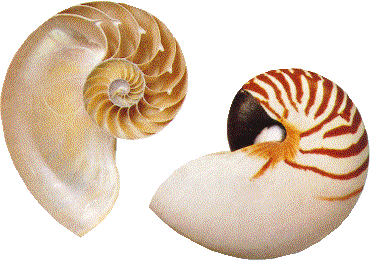| The last surviving genus of the ancient order Nautiloidea is the Nautilus which has a coiled external shell. The Nautilus shell, 20cm in diameter, is planispiral and ornamented externally with a radial colour banding of irregular and bilaterally symmetrical orange-brown stripes. |  |
| Figure 22: The pearly Nautilus (shown above) has a small, coiled shell that can grow to about 10 inches in diameter, and can consist of 36 chambers. |
Nautilus has a rather complex reproductive pattern. The sexes are
separate; testes and ovaries are to be found at the posterior extremity
of the body. During copulation the male transfers a ball of sperm
to the mantle cavity of the female using a specially adapted erectile
group of tentacles.
There is a prominent variation in size according to the gender of
the animal, the shell of the male being slightly smaller than that
of the female; this is because the female requires a larger body
size for egg production.
Nautilus, being an active carnivore, has a highly organised brain
coupled with good sense organs and a complex behaviour pattern.
When hunting, Nautilus spreads its outer tentacles, but when it captures
food it uses the inner tentacles to handle it.
The sutures of Nautiloids are simple in shape, being either
straight or slightly curved.


